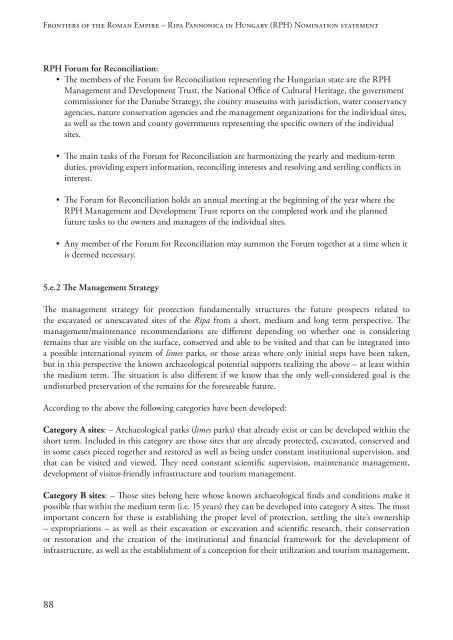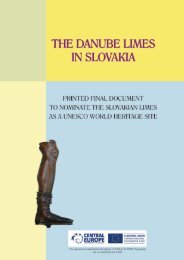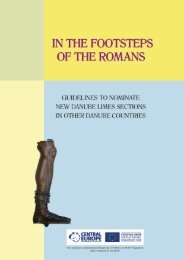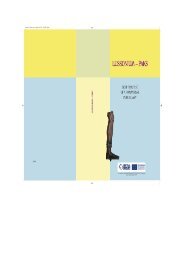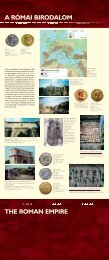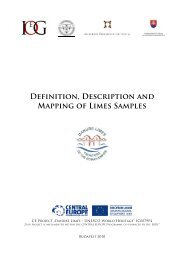the PDF version! - Danube Limes
the PDF version! - Danube Limes
the PDF version! - Danube Limes
You also want an ePaper? Increase the reach of your titles
YUMPU automatically turns print PDFs into web optimized ePapers that Google loves.
Frontiers of <strong>the</strong> Roman Empire – Ripa Pannonica in Hungary (RPH) Nomination statement<br />
RPH Forum for Reconciliation:<br />
• The members of <strong>the</strong> Forum for Reconciliation representing <strong>the</strong> Hungarian state are <strong>the</strong> RPH<br />
Management and Development Trust, <strong>the</strong> National Office of Cultural Heritage, <strong>the</strong> government<br />
commissioner for <strong>the</strong> <strong>Danube</strong> Strategy, <strong>the</strong> county museums with jurisdiction, water conservancy<br />
agencies, nature conservation agencies and <strong>the</strong> management organizations for <strong>the</strong> individual sites,<br />
as well as <strong>the</strong> town and county governments representing <strong>the</strong> specific owners of <strong>the</strong> individual<br />
sites.<br />
• The main tasks of <strong>the</strong> Forum for Reconciliation are harmonizing <strong>the</strong> yearly and medium-term<br />
duties, providing expert information, reconciling interests and resolving and settling conflicts in<br />
interest.<br />
• The Forum for Reconciliation holds an annual meeting at <strong>the</strong> beginning of <strong>the</strong> year where <strong>the</strong><br />
RPH Management and Development Trust reports on <strong>the</strong> completed work and <strong>the</strong> planned<br />
future tasks to <strong>the</strong> owners and managers of <strong>the</strong> individual sites.<br />
• Any member of <strong>the</strong> Forum for Reconciliation may summon <strong>the</strong> Forum toge<strong>the</strong>r at a time when it<br />
is deemed necessary.<br />
5.e.2 The Management Strategy<br />
The management strategy for protection fundamentally structures <strong>the</strong> future prospects related to<br />
<strong>the</strong> excavated or unexcavated sites of <strong>the</strong> Ripa from a short, medium and long term perspective. The<br />
management/maintenance recommendations are different depending on whe<strong>the</strong>r one is considering<br />
remains that are visible on <strong>the</strong> surface, conserved and able to be visited and that can be integrated into<br />
a possible international system of limes parks, or those areas where only initial steps have been taken,<br />
but in this perspective <strong>the</strong> known archaeological potential supports realizing <strong>the</strong> above – at least within<br />
<strong>the</strong> medium term. The situation is also different if we know that <strong>the</strong> only well-considered goal is <strong>the</strong><br />
undisturbed preservation of <strong>the</strong> remains for <strong>the</strong> foreseeable future.<br />
According to <strong>the</strong> above <strong>the</strong> following categories have been developed:<br />
Category A sites: – Archaeological parks (limes parks) that already exist or can be developed within <strong>the</strong><br />
short term. Included in this category are those sites that are already protected, excavated, conserved and<br />
in some cases pieced toge<strong>the</strong>r and restored as well as being under constant institutional supervision, and<br />
that can be visited and viewed. They need constant scientific supervision, maintenance management,<br />
development of visitor-friendly infrastructure and tourism management.<br />
Category B sites: – Those sites belong here whose known archaeological finds and conditions make it<br />
possible that within <strong>the</strong> medium term (i.e. 15 years) <strong>the</strong>y can be developed into category A sites. The most<br />
important concern for <strong>the</strong>se is establishing <strong>the</strong> proper level of protection, settling <strong>the</strong> site’s ownership<br />
– expropriations – as well as <strong>the</strong>ir excavation or excavation and scientific research, <strong>the</strong>ir conservation<br />
or restoration and <strong>the</strong> creation of <strong>the</strong> institutional and financial framework for <strong>the</strong> development of<br />
infrastructure, as well as <strong>the</strong> establishment of a conception for <strong>the</strong>ir utilization and tourism management.<br />
88


